The Microstructure, Solidification Path, and Microhardness of As-Cast Ni-Al-Cr-Os Alloys in a Ni-Rich Region
Abstract
:1. Introduction
2. Experimental Procedure
3. Results and Discussion
3.1. Microstructures of As-Cast Ni-Al-Cr-Os Quaternary Alloys
3.2. Solidification Path of Ni-Al-Cr-Os Quaternary Alloys
3.3. Microhardness Values of As-Cast Ni-Al-Cr-Os Quaternary Alloys and Their Correlation with As-Cast Microstructures
4. Summary
Author Contributions
Funding
Institutional Review Board Statement
Informed Consent Statement
Data Availability Statement
Conflicts of Interest
References
- Alabort, E.; Barba, D.; Sulzer, S.; Lißner, M.; Petrinic, N.; Reed, R.C. Grain boundary properties of a nickel-based superalloy: Characterisation and modelling. Acta Mater. 2018, 151, 377–394. [Google Scholar] [CrossRef]
- Zhang, D.S.; Liu, W.; Li, Y.X.; Sun, D.; Wu, Y.; Luo, S.N.; Chen, S.; Tao, T.; Zhang, B.B. In sutiobservation of crystal rotation in Ni-based superalloy during additive manufacturing process. Nat. Commun. 2023, 14, 2961. [Google Scholar] [CrossRef] [PubMed]
- Ren, N.; Li, J.; Panwisawas, C.; Xia, M.X.; Dong, H.B.; Li, J.G. Thermal-solutal-fliud flow of channel segregation during directional solidification of single-crystal nickel-based superalloys. Acta Mater. 2021, 206, 116620. [Google Scholar] [CrossRef]
- Bagot, P.A.J.; Silk, O.B.W.; Douglas, J.O.; Pedrazzini, S.; Crudden, D.J.; Martin, T.L.; Hardy, M.C.; Moody, M.P.; Reed, R.C. An Atom Probe Tomography study of site preference and partitioning in a nickel-based superalloy. Acta Mater. 2017, 125, 156–165. [Google Scholar] [CrossRef]
- Acharya, M.V.; Fuchs, G.E. The effect of stress on the microstructural stability of CMSX-10 single crystal Ni-base superalloys. Scr. Mater. 2006, 54, 61–64. [Google Scholar] [CrossRef]
- Dodaran, M.; Hemmasian Ettefagh, A.; Guo, S.M.; Khonsari, M.M.; Meng, W.J.; Shamsaei, N.; Shao, S. Effect of alloying elements on the γ′ antiphase boundary energy in Ni-base superalloys. Intermetallics 2020, 117, 106670. [Google Scholar] [CrossRef]
- Lavenstein, S.; Crawford, B.; Sim, G.D.; Shade, P.A.; Woodward, C.; El-Awady, J.A. High frequency in situ fatigue response of Ni-base superalloy Rene-N5 microcrystals. Acta Mater. 2018, 144, 154–163. [Google Scholar] [CrossRef]
- Long, H.B.; Mao, S.C.; Liu, Y.N.; Zhang, Z.; Han, X.D. Microstructural and compositional design of Ni-based single crystalline superalloys-A review. J. Alloys Compd. 2018, 743, 203–220. [Google Scholar] [CrossRef]
- Fink, P.J.; Miller, J.L.; Konizer, D.G. Rhenium Reduction-Alloy Design Using an Economically Strategic Element. JOM 2010, 62, 55–57. [Google Scholar] [CrossRef]
- Tian, S.G.; Su, Y.; Qian, B.J.; Yu, X.F.; Liang, F.; Li, S.A. Creep behavior of a single crystal nickel-based superalloy containing 4.2% Re. Mater. Des. 2012, 37, 236–242. [Google Scholar] [CrossRef]
- Reed, R.C.; Zhu, Z.; Sato, A.; Crudden, D.J. Isolation and testing of new single crystal superalloys using alloys-by-design method. Mater. Sci. Eng. A 2016, 667, 261–278. [Google Scholar] [CrossRef]
- Chen, J.; Zhong, C.; Wang, J.; Chen, W.; Tang, Y.; Zhang, L.; Du, Y. Thermodynamic description, diffusivities and atomic mobilities in binary Ni-Os system. Calphad 2015, 50, 118–125. [Google Scholar] [CrossRef]
- Chen, J.; Zhang, L.; Lu, X.G. Screening of possible Re-substitutional elements in single crystal Ni-based superalloys: A viewpoint from interdiffusion coefficients in Ni-Al-X ternaries. Metall. Mater. Trans. A 2018, 49, 2999–3010. [Google Scholar] [CrossRef]
- Köster, W.; Horn, E. Study of Osmium with Cobalt and Nickel; Festschrift aus Anlass des 100-Jahrigen Jubilaums der Firma W. C.; Heraeus GmBH: Hanau, Germany, 1951; pp. 114–123. [Google Scholar]
- Velikanova, T.Y.; Mazhuga, T.G.; Semenova, O.L.; Martsenyuk, P.S.; Vereshchaka, V.M. Phase diagram of the Ni-Os system. Powder Metall. Met. Ceram. 2002, 41, 288–295. [Google Scholar] [CrossRef]
- Lin, Y.; Wei, M.; Li, G.; Zhang, L. Phase equilibria and microhardness of as-cast and annealed Ni-Al-Os alloys in Ni-rich region. J. Phase Equilib. Diffus. 2018, 39, 944–952. [Google Scholar] [CrossRef]
- Wei, B.S.; Lin, Y.; Huang, Z.W.; Huang, L.; Zhou, K.C.; Zhang, L.J. A novel Re-free Ni-based single-crystal superalloy with enhanced creep resistance and microstructure stability. Acta Mater. 2022, 240, 118336. [Google Scholar] [CrossRef]
- Gancarczyk, K.; Zubko, M.; Hanc-kuczkowska, A.; Kocielniak, B.; Albrecht, R.; Szelige, D.; Motyka, M.; Ziaja, W.; Sieniawski, J. The Effect of Withdrawal Rate on Crystal Structure Perfection, Microstructure and Creep Resistance of Single Crystal Castings Made of CMSX-4 Nickel-Based Superalloy. Materials 2019, 12, 3422. [Google Scholar] [CrossRef]
- D’Souza, N.; Roebuck, B.; Collins, D.M.; West, G.D.; Panwisawas, C. Relating micro-segregation to site specific high temperature deformation in sing crystal nickel-base superalloy castings. Mater. Sci. Eng. A 2020, 773, 138862. [Google Scholar] [CrossRef]
- Cao, K.L.; Yang, W.C.; Zhang, J.C.; Liu, C.; Qu, P.F.; Su, H.J.; Zhang, J.; Liu, L. Solidification characteristics and as-cast microstructures of a Ru-containing nickel-based single crystal superalloy. J. Mater. Res. Technol. 2021, 11, 474–486. [Google Scholar] [CrossRef]
- Taylor, A.; Doyle, N.J. The constitution diagram of the tungsten-molybdenum-osmium system. J. Less-Common Metals. 1965, 9, 190–205. [Google Scholar] [CrossRef]
- Venkatraman, M.; Neumann, J.P. The Cr-Os system. Bull. Alloy Phase Diagr. 1990, 11, 9–10. [Google Scholar] [CrossRef]
- Hilpert, K.; Kobertz, D.; Venugopal, V.; Miller, M.; Gerads, H.; Bremer, F.J.; Nickel, H. Phase Diagram Studies on the Al-Ni System. Z. Naturforsch. A 1987, 42, 1327–1332. [Google Scholar] [CrossRef]
- Merchant, S.M.; Notis, M.R. A review: Constitution of the Al-Cr-Ni system. Mater. Sci. Eng. 1984, 66, 47–60. [Google Scholar] [CrossRef]
- Taylor, A.; Floyd, R.W. The constitution of nickel-rich alloys of the nickel chromium aluminium system. J. Inst. Met. 1953, 81, 451–464. [Google Scholar]
- Huang, W.; Chang, Y.A. Thermodynamic properties of the Ni-Al-Cr system. Intermetallics 1999, 7, 863–874. [Google Scholar] [CrossRef]
- Huang, W.; Chang, Y.A. A thermodynamic description of the Ni-Al-Cr-Re system. Mater. Sci. Eng. A 1999, 259, 110–119. [Google Scholar] [CrossRef]
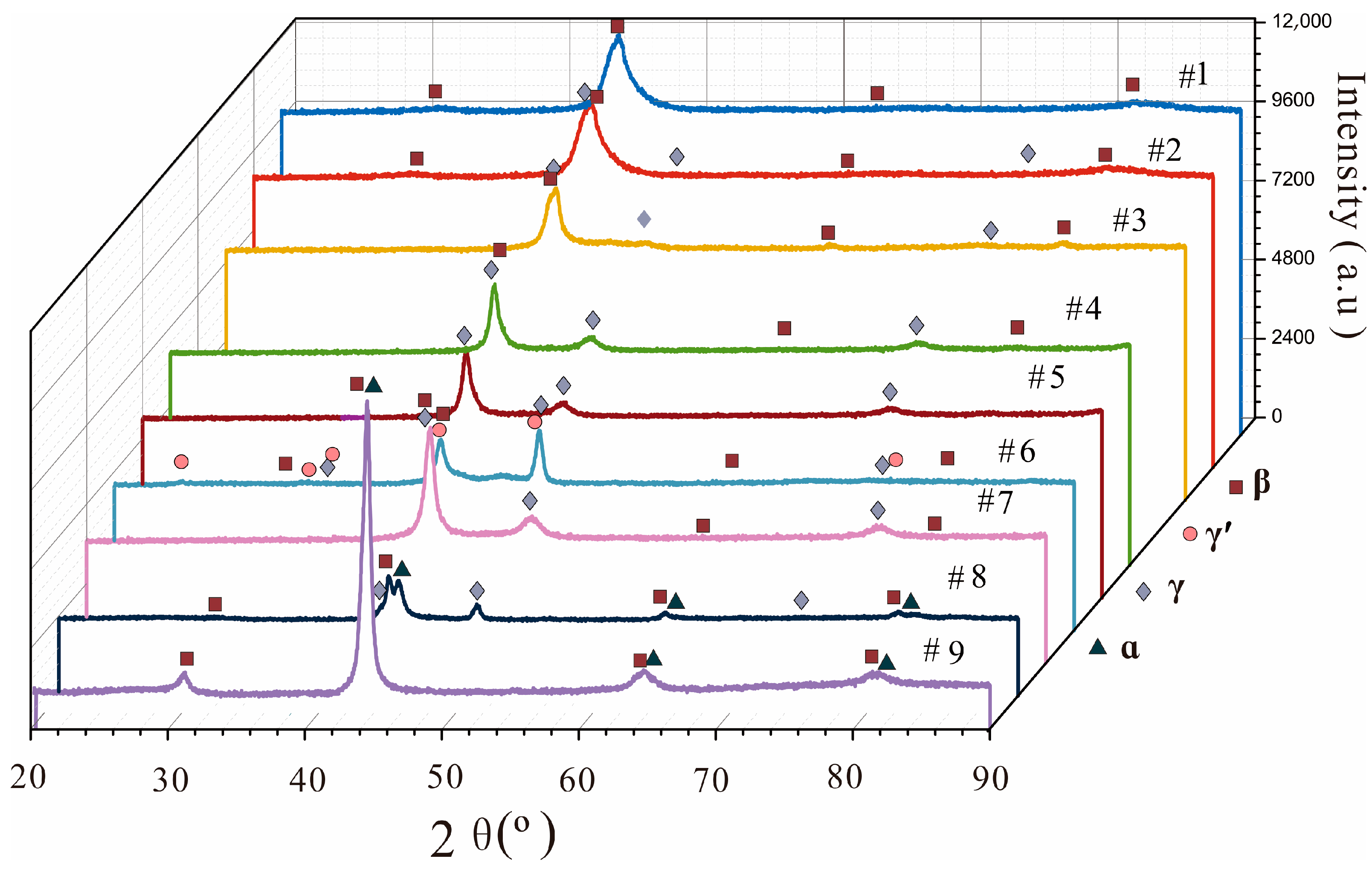

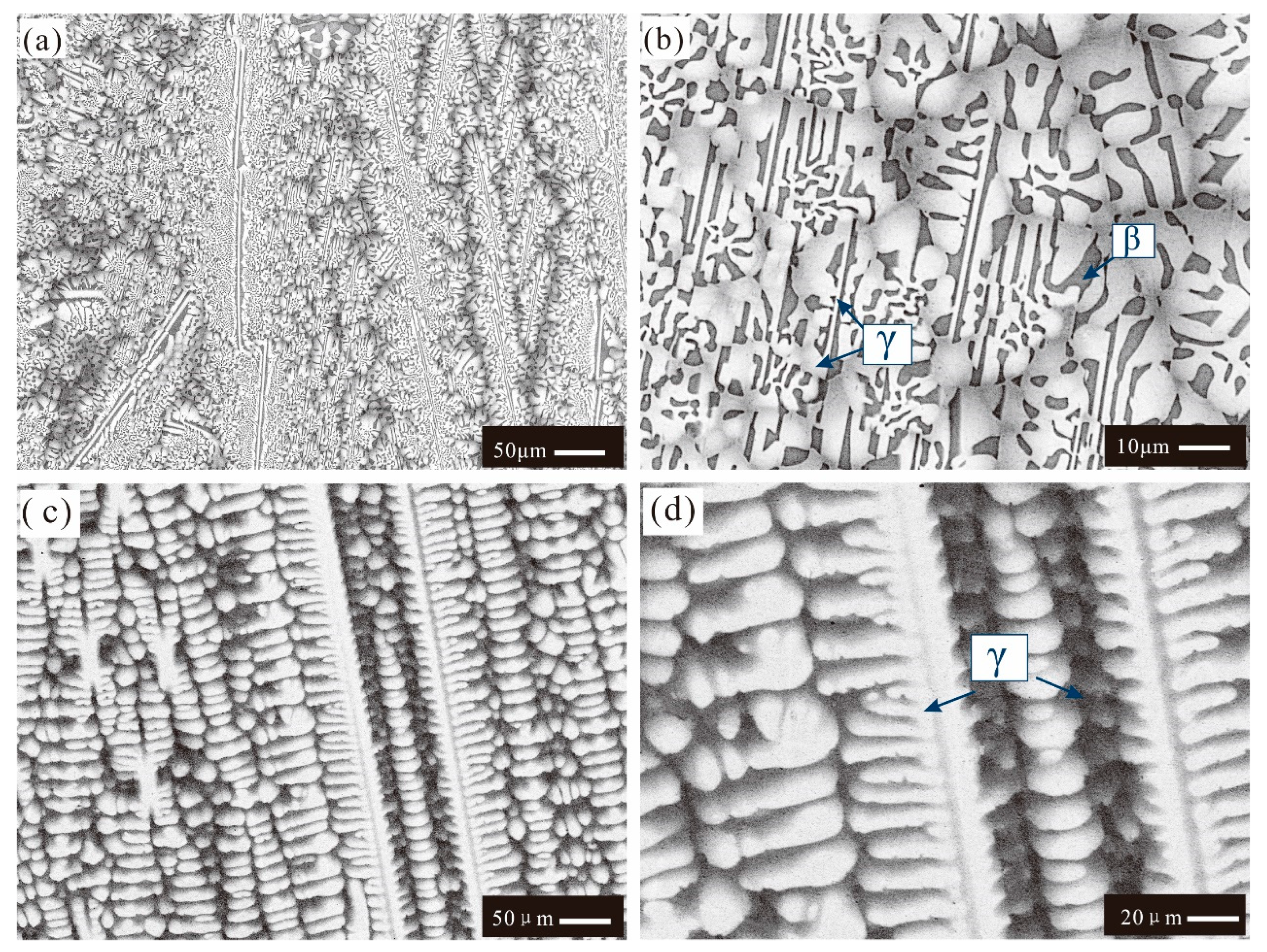
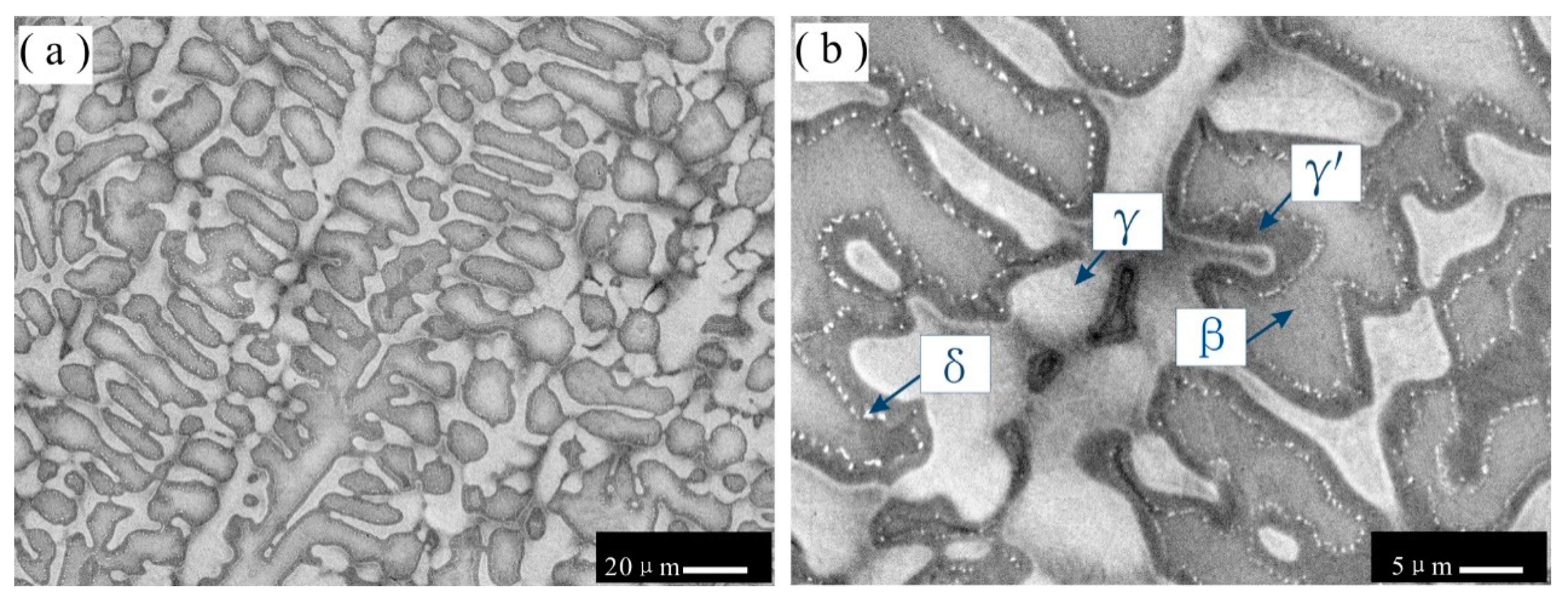
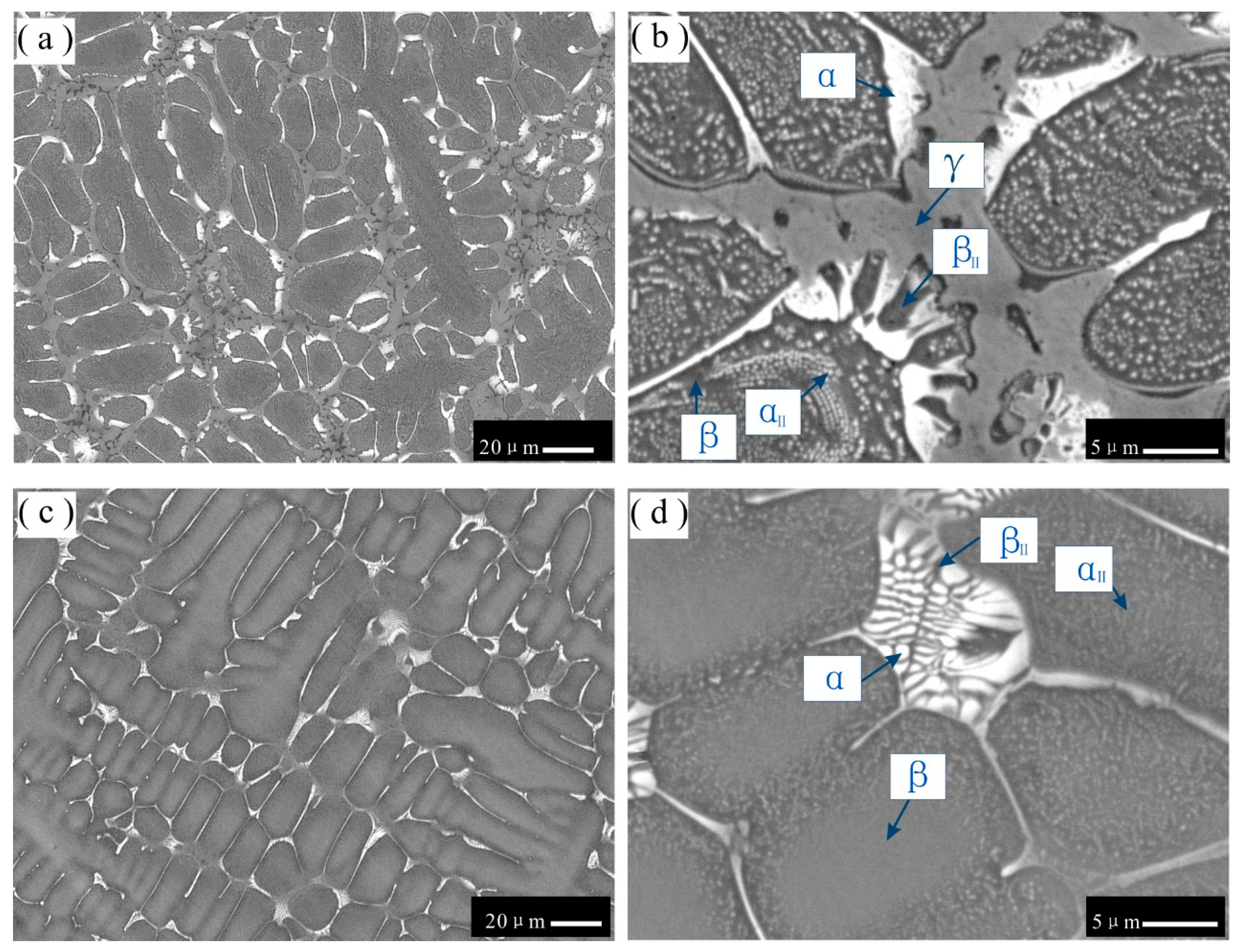
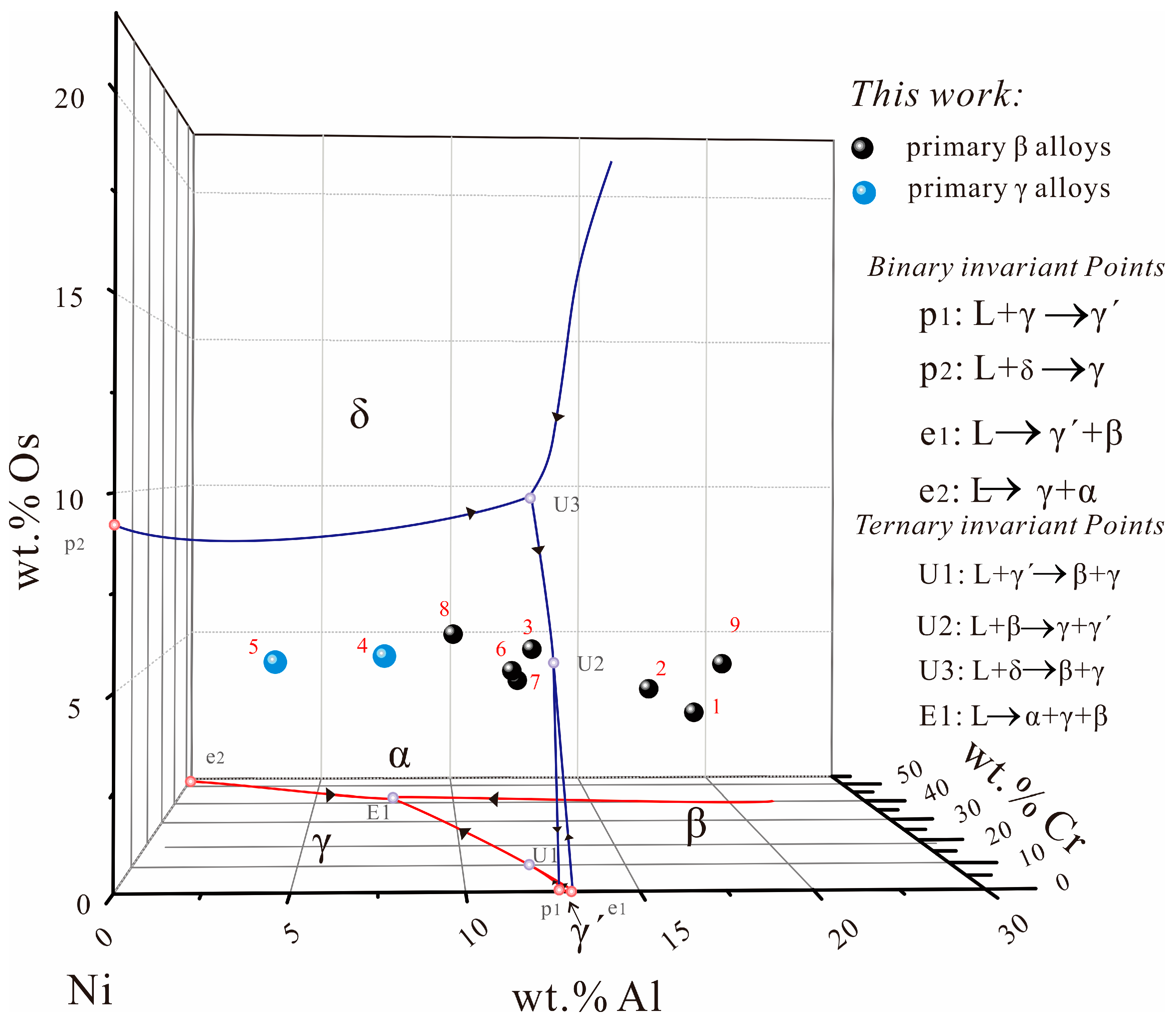
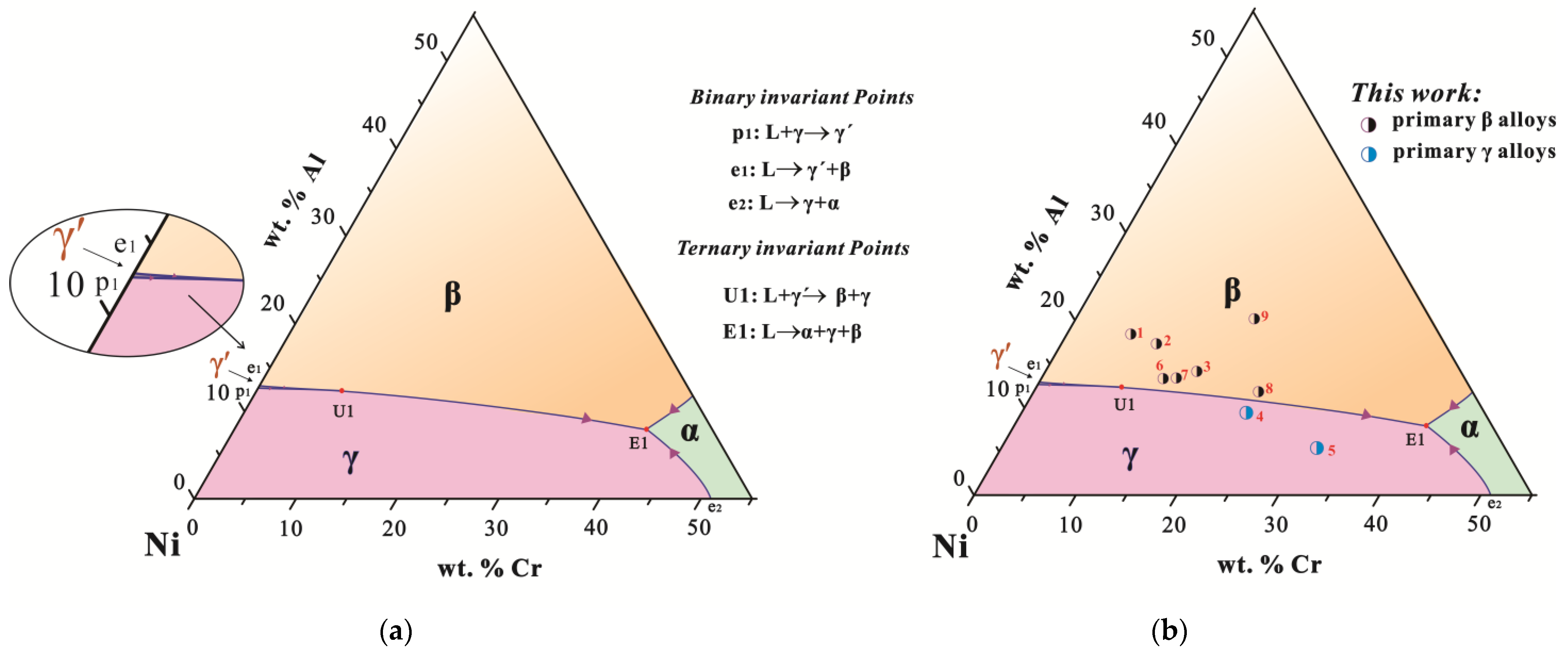

| No. | Alloy Composition (wt.%) | Phase | Solidification Path | Phase Fraction |
|---|---|---|---|---|
| 1 | Ni74.0Al16.8Cr4.9Os4.3 | β | L → β | 100% β |
| 2 | Ni71.2Al15.6Cr7.8Os4.8 | β, γ | L → β L → β + γ | 95% β, 5% γ |
| 3 | Ni69.1Al12.2Cr13.0Os5.7 | β, γ | L → β L → β + γ | 77% β, 23% γ |
| 4 | Ni66.7Al7.6Cr20.4Os5.3 | γ, β | L → γ L → γ + β | 31% β, 69% γ |
| 5 | Ni61.9Al3.8Cr29.5Os4.8 | γ | L → γ | 100% γ |
| 6 | Ni73.0Al11.5Cr10.3Os5.2 | β, γ, γʹ, δ | L → β L + β → γʹ or L→ β + γʹ L →γ | 28.2% β, 37% γ, 32% γʹ, 2.8% δ |
| 7 | Ni71.9Al11.7Cr11.5Os4.9 | β, γ | L → β L → β + γ | 62% β, 38% γ |
| 8 | Ni64.0Al9.8Cr20.2Os5.9 | β, γ, α | L → β L → β +γ + α | 33% β, 17.5% γ, 49.5% α |
| 9 | Ni60.6Al18.3Cr15.9Os5.2 | β, α | L → β L → β + α | 93.4% β, 6.6% α |
Disclaimer/Publisher’s Note: The statements, opinions and data contained in all publications are solely those of the individual author(s) and contributor(s) and not of MDPI and/or the editor(s). MDPI and/or the editor(s) disclaim responsibility for any injury to people or property resulting from any ideas, methods, instructions or products referred to in the content. |
© 2023 by the authors. Licensee MDPI, Basel, Switzerland. This article is an open access article distributed under the terms and conditions of the Creative Commons Attribution (CC BY) license (https://creativecommons.org/licenses/by/4.0/).
Share and Cite
Lin, Y.; Wei, M.; Yang, G.; Liu, H.; Ye, H.; Deng, C.; Zhang, L. The Microstructure, Solidification Path, and Microhardness of As-Cast Ni-Al-Cr-Os Alloys in a Ni-Rich Region. Materials 2023, 16, 6777. https://doi.org/10.3390/ma16206777
Lin Y, Wei M, Yang G, Liu H, Ye H, Deng C, Zhang L. The Microstructure, Solidification Path, and Microhardness of As-Cast Ni-Al-Cr-Os Alloys in a Ni-Rich Region. Materials. 2023; 16(20):6777. https://doi.org/10.3390/ma16206777
Chicago/Turabian StyleLin, Yan, Ming Wei, Guangyu Yang, Haiyan Liu, Hui Ye, Chunming Deng, and Lijun Zhang. 2023. "The Microstructure, Solidification Path, and Microhardness of As-Cast Ni-Al-Cr-Os Alloys in a Ni-Rich Region" Materials 16, no. 20: 6777. https://doi.org/10.3390/ma16206777






